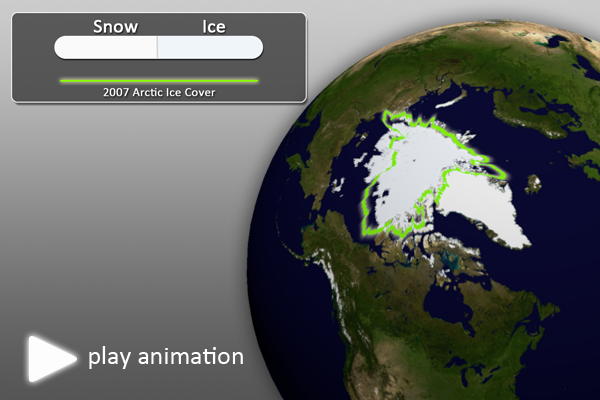On August 26, the Arctic ice extent dropped below the previous record low daily extent, observed on September 18, 2007, of 4.17 million square kilometers (1.61 million square miles). Since then, the sea ice ice has dropped to below 4 million square kilometers (1.54 million square miles).

2012 vs. 2007 Sea Ice Comparison • Animation not work? Click Here • Still Map Image
2007 Sea Ice Comparison
- This dataset visualization compares a recent sea ice extent image (August 26) with the 2007 sea ice minimum
- The yellow/green line marks the 2007 sea ice minimum.
- Note: Be sure to point out that Greenland is not a part of these sea ice calculations, as it is a land mass. The ice on Greenland is referred to as an ice sheet.
While the official 2012 minimum extent can’t be declared until the summer melt season is over (probably later this week), the final figure is expected to be lower than it currently is.
In 2012, the rate of ice loss for August was 91,700 square kilometers (35,400 square miles) per day, the fastest observed for the month of August since 1979 (when satellite monitoring began). In 2007, the August rate of ice melt was 66,000 square kilometers (25,400 square miles) per day. The average ice loss for August is 55,100 square kilometers (21,300 square miles) per day. Arctic air temperatures were slightly above to slightly below average, depending on location. Some of the ice loss can be attributed to a large cyclone near the East Siberian Sea, which helped to break up some of the ice.
According to NSIDC (National Snow and Ice Data Center) Director Mark Serreze, “The previous record, set in 2007, occurred because of near perfect summer weather for melting ice. Apart from one big storm in early August, weather patterns this year were unremarkable. The ice is so thin and weak now, it doesn’t matter how the winds blow. The Arctic used to be dominated by multiyear ice, or ice that stayed around for several years. Now it’s becoming more of a seasonal ice cover and large areas are now prone to melting out in summer.”
Where do I find the dataset?
- First, check your SOS system to make sure it’s not already in the EarthNow category. There is also an earthnow.sos playlist file that includes a playlist with this dataset as well as the real-time snow and ice cover dataset.
- If not, you can download the dataset and playlist files from this FTP Site.
Helpful Resources for More Information
- http://nsidc.org/ National Snow and Ice Data Center
- http://arctic.atmos.uiuc.edu/cryosphere/arctic.sea.ice.interactive.html Interactive Sea Ice Graph






